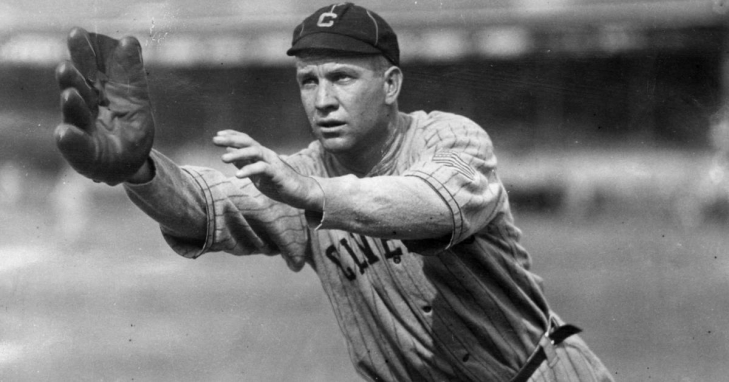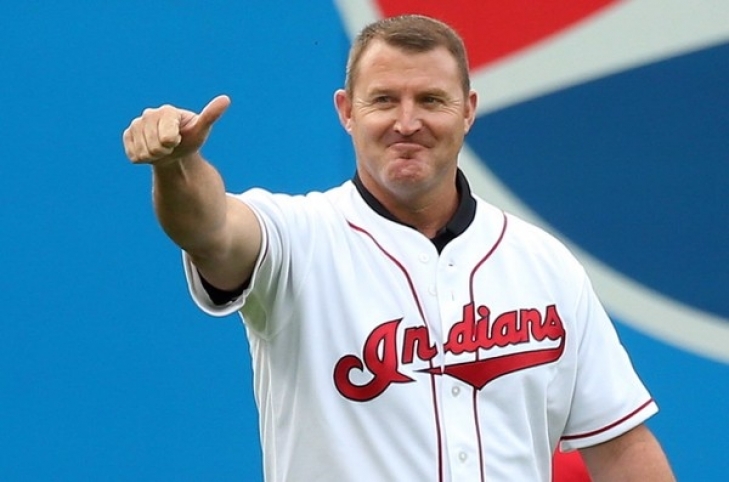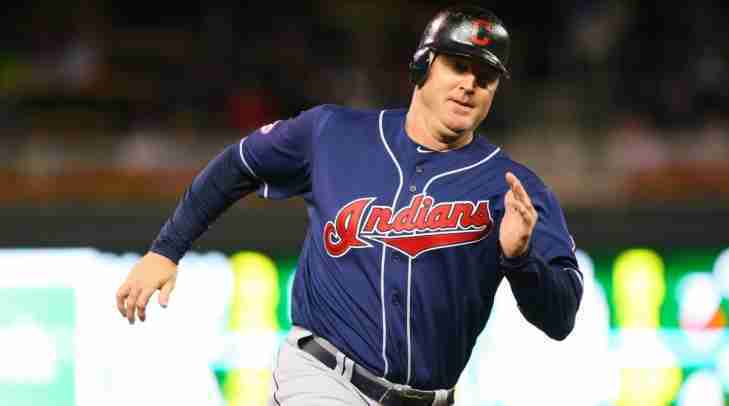19. Albert Belle
Albert Belle was the most prolific slugger for the Indians in the 1990s. Coincidentally, he was also their most infamous player of the decade.
7. Jose Ramirez
Jose Ramirez is another in the great line of infielders that the Dominican Republic produced, and to date, he has only plied his trade with the Cleveland Indians.
18. Mike Garcia
In the first half of the 1950s, Mike Garcia was part of an excellent pitching staff that the Cleveland Indians had that boasted Bob Lemon, Early Wynn, and Bob Feller. Garcia was then and now in the shadows of those more prominent names, but he was a star in his own right.
21. Shoeless Joe Jackson
The career of “Shoeless” Joe Jackson is mostly known in Chicago for his participation (or lack thereof) in the 1919 “Black Sox” scandal. That isn’t wrong, but it was in Cleveland where Jackson had his most productive years as a baseball player.
4. Lou Boudreau
A two-sport star (Basketball and Baseball) at the University of Illinois, Lou Boudreau focused on Baseball, and the Cleveland Indians were blessed by that decision.
3. Tris Speaker
The Boston Red Sox made another regrettable trade before they jettisoned Babe Ruth to the New York Yankees. A couple of years early, they traded Centerfielder Tris Speaker, who they asked to take a pay cut after an off-year (where he still batted .322!). Speaker refused, and the former MVP two-time World Series Champion and was traded to Cleveland in 1916.
17. Corey Kluber
Corey Kluber was one of the top hurlers in the American League throughout the 2010s, which could have happened in the NL had San Diego never traded him before he made the Majors. Kluber came to Cleveland as part of a three-team trade in 2010, and after a few games in the next two years, he would make the starting rotation.
13. Early Wynn
Early Wynn was an established star with the Washington Senators, and his career achieved greater heights when he was traded to the Cleveland Indians after the 1948 Season.
5. Bob Lemon
Bob Lemon sought out his baseball journey as an everyday player in the Outfield, first debuting in 1941, playing five Games that year and another five in 1942 at the Major League level. During World War II, he joined the Military, missing three years but returned at age 25 and was set to become the starting Centerfielder. He got off to a great start, with a spectacular diving catch saving the win for the Indians. Despite this, the Indians had other ideas, as they needed pitching help and thought his past experience on the mound would serve the team better. They would be right.
2. Bob Feller
In our eyes, Bob Feller is not just the greatest Pitcher in the history of the Cleveland Indians, but he is the greatest player ever to play for the team. As seen by the names that follow him on this list, it wasn't an easy decision, but Feller's overall accomplishments proved just too challenging for any other Cleveland Indian to overcome.
6. Stan Coveleski
Stan Coveleski did not accomplish much in his brief time with the Philadelphia Athletics in 1912, and after a few years in the minors, Covelski was back and ready to dominate.
12. Sam McDowell
Sam McDowell had one of the most unimposing yet correct nicknames. When you hear the name "Sudden" Sam, you aren't sure what to think, but what does a "sudden" Pitcher mean? For McDowell, it is in reference to his rapid delivery and the strong odds that he would strike you out.
8. Earl Averill
Earl Averill was the best player for the Indians throughout the 1930s, which was made more impressive as he did not make it to the Majors until he was 27.
1. Nap Lajoie
If anyone was going to be number one on this list over Bob Feller, it is Napoleon Lajoie, who we are still openly debating whether we made a mistake on this one.
15. Larry Doby
A star with the Newark Eagles of the Negro Leagues, Larry Doby was the first African-American player in the American League when he debuted for the Cleveland Indians in 1947.
80. Bartolo Colon
Bartolo Colon was a rotund individual, but pound for pound he was one of the most charismatic players in baseball, and doesn’t that say something?
The Cleveland Indians retired Jim Thome's number 25
As most of the regular visitors to Notinhalloffame.com are aware we are (very) slowly putting together our top 50 players of every franchise in the “Big 4” of North American sports. After that is completed we will take a look at how each organization honors their past players and executives.
As such, it is important to us that the Cleveland Indians have retired the number 25 yesterday of Jim Thome in a pre-game ceremony.
2018 has been somewhat of a celebration year for Thome who earlier this year was inducted into the Baseball Hall of Fame. Last week, the Chicago White Sox honored him for his accomplishments for them and in June the Philadelphia Phillies did the same. The Minnesota Twins will be honoring Thome next Saturday.
Thome played for six teams over his career over half of which was spent with the Indians. He went to three All Star Games as an Indian where he hit 337 Home Runs with a .287/.414/.566 Slash Line. He is the all time franchise leader in Home Runs. His #25 joins Earl Averill (#3), Lou Boudreau (#5), Larry Doby (#14), Mel Harder (#18), Bob Feller (#19), Bob Lemon (#21) and Jackie Robinson (#42).
We here at Notinhalloffame.com would like to congratulate Jim Thome for earning this prestigious honor.
If Jim Thome has his way Chief Wahoo will not be on his plaque
Thome, who was inducted in his first attempt and will go in as an Indian is requesting that the “C” will adorn his cap. While the final decision on the hat on the plaque lies with Cooperstown there is no reason to think that there should be an issue. There are fourteen Hall of Famers who went in as Indians and only one (Early Wynn) has Chief Wahoo on the hat. The rest have no logo or a varying version of the “C”.
As for why Thome made this decision he had this to say:
"I know my decision would be to wear the 'C' because I think it's the right thing to do, I think I need to have a conversation with the Hall of Fame because of all the history and everything involved. I just think that's the right thing to do."
From our point of view, we applaud the decision of Thome and are again congratulating him on entering the Baseball Hall of Fame.
Jim Thome, Albert Belle and Frank Robinson to enter the Cleveland Indians HOF
The Class of 2016 consists of Jim Thome, Albert Belle, Frank Robinson and Charlie Jamieson, who will all be officially inducted a ceremony on July 30.
Jim Thome played for the Tribe for thirteen seasons, first coming up in the 1995 season and staying there until he signed with the Philadelphia Phillies for the 2003 season. As an Indian, Thome would make three All Star Games, and won a Silver Slugger. Statistically, Thome accumulated 1,353 Hits, 337 Home Runs with a Slash Line of .287/.414/.566 and a bWAR of 47.9. Thome is a strong candidate for the Baseball Hall of Fame and is eligible for Cooperstown in 2018.
Albert Belle was a powerful slugger for Cleveland in the 1990’s where he was a four time All Star. Belle finished in the top three in American League MVP voting three times and was a Silver Slugger four times as an Indian. Belle would lead the AL in RBIS three times, Home Runs once, as well as winning the Slugging Title in 1995. Overall Albert Belle’s Cleveland numbers saw him tally 1,014 Hits, 242 Home Runs with a .295/.369./.580 Slash Line and a bWAR of 30.1.
Frank Robinson spent his last few years as a player as an Indian, but Robinson made history as the first African-American Manager in MLB history when he took over the helm in 1974, as a Player Manager. He would be the Indians Manager for two and a half years.
Charlie Jamieson was a member of Cleveland’s 1920 World Series Championship team. As an Indian, Jamieson would play fourteen seasons and led the league in Hits in 1923 and finished third MVP voting the following year. As a Cleveland Indian, Jamieson smacked 1,793 Hits with a Slash Line of .316/.388/.406 Slash Line with a bWAR of 21.8.
This new crop of inductees brings the total to 44 members of the Cleveland Indians Hall of Fame.
We here at Notinhalloffame.com would like to congratulate the latest group to this Hall of Fame.
16. Wes Ferrell
Athletes are competitive by nature, but 99.9 percent of them paled to the competitive juices of Wes Ferrell. He was known to get violent whenever he lost and take it out on himself and inanimate objects. He may have been animated himself at times, but his teammates have always said they wanted him on their side.





















